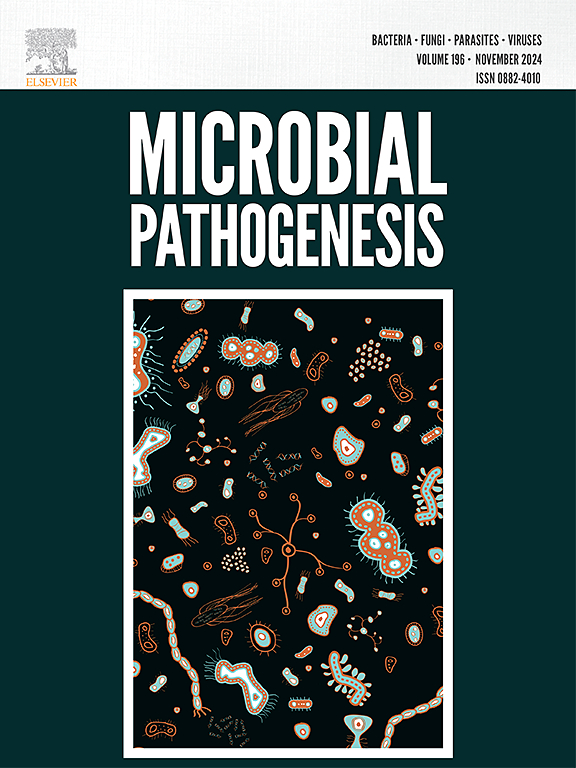壳聚糖和载姜黄素壳聚糖纳米颗粒对新城疫病毒分离物的体外抗病毒活性研究。
IF 3.5
3区 医学
Q3 IMMUNOLOGY
引用次数: 0
摘要
新城疫病毒(NDV)是一种高度传染性的禽类病原体,需要有效的抗病毒策略。本研究评估了壳聚糖纳米颗粒(CNPs)和载姜黄素壳聚糖纳米颗粒(curc -CNPs)对印度喀拉拉邦禽源NDV毒株的体外抗病毒效果。采用靶向F基因的逆转录聚合酶链反应(RT-PCR)对40个疑似禽群进行筛选,阳性率为12.5%。测序根据F蛋白切割位点的氨基酸基序确认了毒力菌株。2个分离株L2/MIB/PKD/23和B3/MIB/PKD/23在鸡胚中繁殖,通过血凝、血凝抑制和平均死亡时间测定证实了它们的毒力。病毒对细胞培养的适应性在鸡胚成纤维细胞中表现出较高的复制效率。采用离子凝胶法制备了CNPs和cu -CNPs,并用光谱和显微技术对其进行了表征。细胞毒性评估结果显示,CNPs的最低非细胞毒性浓度为187.5 μg/mL, Cur-CNPs的最低非细胞毒性浓度为1.47 μg/mL。MTT试验显示,Cur-CNPs对两株菌株的抗病毒活性最高(0.75:1),分别达到44.18%和47.12%。病毒滴度降低试验表明TCID50降低了3.00 log10,血凝滴度降低了两倍。实时荧光定量PCR证实病毒载量显著降低(p本文章由计算机程序翻译,如有差异,请以英文原文为准。
In vitro antiviral activity of chitosan and curcumin-loaded chitosan nanoparticles against virulent Newcastle disease virus isolates
Newcastle disease virus (NDV) is a highly contagious avian pathogen requiring effective antiviral strategies. This study evaluated the in vitro antiviral efficacy of chitosan nanoparticles (CNPs) and curcumin-loaded chitosan nanoparticles (Cur-CNPs) against virulent NDV isolates from poultry in Kerala, India. Screening of 40 suspected flocks by reverse transcription polymerase chain reaction (RT-PCR) targeting the fusion (F) gene revealed a 12.5 % positivity rate. Sequencing confirmed virulent strains based on amino acid motifs at the F protein cleavage site. Two isolates, L2/MIB/PKD/23 and B3/MIB/PKD/23, were propagated in embryonated chicken eggs, and their virulence was confirmed through hemagglutination, hemagglutination inhibition, and mean death time assays. Virus adaptation to cell culture demonstrated higher replication efficiency in chicken embryo fibroblast cells.
CNPs and Cur-CNPs were synthesised via ionic gelation and characterized by spectroscopic and microscopic techniques. Cytotoxicity assessment determined minimum non-cytotoxic concentrations of 187.5 μg/mL for CNPs and 1.47 μg/mL for Cur-CNPs. Antiviral activity, evaluated by MTT assay, demonstrated the highest protection with Cur-CNPs (0.75:1 ratio), achieving 44.18 % and 47.12 % protection for the two isolates. Viral titre reduction assays indicated a decrease of 3.00 log10 in TCID50 and a twofold reduction in hemagglutination titres. Quantitative real-time PCR confirmed significant viral load reductions (p < 0.001) with Cur-CNPs compared to CNPs.
These findings indicate that Cur-CNPs exhibit strong antiviral activity against NDV and may serve as potential alternatives to conventional antiviral agents for Newcastle disease control.
求助全文
通过发布文献求助,成功后即可免费获取论文全文。
去求助
来源期刊

Microbial pathogenesis
医学-免疫学
CiteScore
7.40
自引率
2.60%
发文量
472
审稿时长
56 days
期刊介绍:
Microbial Pathogenesis publishes original contributions and reviews about the molecular and cellular mechanisms of infectious diseases. It covers microbiology, host-pathogen interaction and immunology related to infectious agents, including bacteria, fungi, viruses and protozoa. It also accepts papers in the field of clinical microbiology, with the exception of case reports.
Research Areas Include:
-Pathogenesis
-Virulence factors
-Host susceptibility or resistance
-Immune mechanisms
-Identification, cloning and sequencing of relevant genes
-Genetic studies
-Viruses, prokaryotic organisms and protozoa
-Microbiota
-Systems biology related to infectious diseases
-Targets for vaccine design (pre-clinical studies)
 求助内容:
求助内容: 应助结果提醒方式:
应助结果提醒方式:


